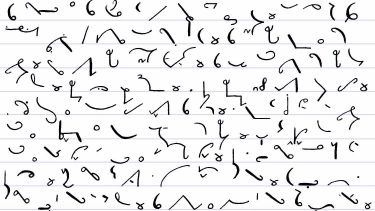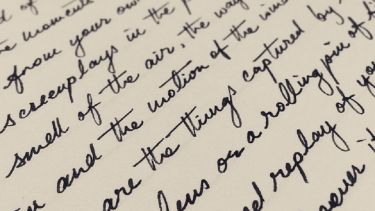Writing Systems #4 - Even Stranger...
After plunging ourselves deep into the mechanics of many different writing systems, known in linguistics as orthographies, we have seen the six major classes of linguistic writing systems known in the world.
We should now know about alphabets, abugidas, abjads, syllabaries, phonographies, and logographies. Yes, I sound like a teacher, I know. With that said, there are always more, and this is not even an exhaustive list of all of the other types of writing systems. Today, I want to introduce you to stenography, steganography and cryptography, pictography and semasiography, calligraphy, palaeography, and pasigraphy. Not many then, right?
Stenographies
A stenography is one of those things that a lot of us have heard about but could probably not describe that well. The term shorthand is probably a more familiar term than stenography, but basically, the linguistic term is stenography, and the lay term is shorthand. Stenographies – yes, there are more than one – act as a sort of quicker way of taking down a lot of spoken information into written form in a short space of time, hence the name shorthand. A stenography uses what are called typograms, these are written elements to letters such as a dot in the ‘j’ or the line in the ‘t’. Typograms are regularly used letter parts that are used purely because of how easy and frequent they are to write, which in turn gives them more ease when trying to preserve as much information as possible. Stenographies are very similar to logographies because common words and affixes (known as morphemes) are generally allocated specific typograms, and in logographies, the morpheme is the smallest unit per written character. Whilst the mechanisms may be similar, stenographies are more of shortcut to preserve more information in a quicker time, logographies, on the other hand, do not use this shortening method.
Steganographies and Cryptographies
Steganography not a writing system per se, but it is more the art of encoding a message within a message. Steganographies are a little stranger than the orthographies we have come up with before, but they are essentially defined as a concealed message within another message (oral, aural, physical, or written). So, basically, they could even appear in paintings, songs, poems, drawings, letters, and so on. The general look of a steganography varies very widely indeed because of this concealment, and really, it would depend upon the imagination and creativity of the individual concealing the message as to how the steganography looks. Above is an example not of a steganography, but instead, a cryptography. This, as most of you will know, is morse code, and the way in which the uncoded message can be recorded is given above. That very written system for the recording and decoding of message – hidden or not – is known as a cryptography. These two are quite cool indeed, especially if you want to go into espionage!
Pictographies and Semasiographies
The two words in the title are basically the same thing. Pictographies are those orthographies that are using pictures (known here as pictograms) as a system of communication, such as in the rather well-known orthography known as emoji. The other, semasiography, is when a sign denotes meaning and communication. So essentially, they are very much the same, and the lines are a little blurred on this one, but you can think of semasiographies only ever using one pictogram at a time, whilst pictographies may use a plurality. Egyptian hieroglyphs can be considered a pictography as well as a logography, but emoji, however, cannot. One possibly denotes linguistic units and does not require other mediums such as colour, whereas emoji does, which restricts it to being solely a pictography or semasiography.
Calligraphies and Palaeography
Now this one may come as a surprise to you, but calligraphies are definitely part of orthographies. Calligraphies have a rare distinction on this list of being the only orthography that can co-occur with all six major classes of orthography, as well as all of those mentioned in this blog (excepting palaeography as that is a little different). Instead of reflecting straightforward linguistic units of meaningful content such as sounds, pitch, semantics, or concepts, calligraphies are more reflective of sociolinguistic factors such as register, formality, setting, and class. You can think of this as the sociolinguistic orthography, of which, all fonts and handwritings are their own individual calligraphies! As well as looking at the major orthographic classes, the other classes mentioned here can be quite useful, not to mention calligraphies in the world of palaeography. This old bean is the study of deciphering historical scripts, so just as calligraphy is where grapholinguistics meets sociolinguistics, palaeography is where historical linguistics and grapholinguistics intersect.
Pasigraphies
So, remember earlier when I said that hieroglyphs of Egypt may be logographic and pictographic, this particular example could be considered more accurately to be a pasigraphy. That is a writing system composed of concepts instead of other well-proven linguistic units. It is not sure in palaeographic terms whether hieroglyphs represent morphemes and are not as pictographic as we first thought. There is, however, one certainty: all characters represent a concept. This kind of orthography can overlap into orthography and include pictographies and semasiographies entirely. Think of mathematical functions such as ‘+’, this corresponds to a generally undecided sound = ‘add’, ‘and’ ‘plus’, and so on. The function it corresponds to is decided upon and is both mathematical and familiar to most people, therefore symbols in maths such as this can be considered to be pasigraphic.
Next time I shall be considering the difference between written versus spoken language…
Written by DP, Digital Student Ambassador, on 17 February 2022.






